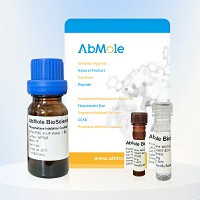All AbMole products are for research use only, cannot be used for human consumption.

Species: Mouse
Expression system: E.coli
Purity: > 95% as determined by reduced SDS-PAGE
Endotoxin: less than 0.001 ng/ug (0.01 EU/ug) as determined by LAL
Storage and stability: Lyophilized proteins should be stored at < -20°C but can be stored at room temperature for up to 3 weeks. The recombinant protein solution can be stored at 4-7℃ for 2-7 days. The isometric solution of the recombinant sample was stable at < -20°C for 3 months.
Bioactivity: C-C Motif chemokine 2 (CCL2) is a member of the C-C or β chemokine family. The amino acid (AA) homology of mouse CCL2 was 82% with rat CCL2, and 58%, 56%, 55%, 53% and 53% with human, horse, pig, cattle and dog CCL2, respectively. Fibroblasts, glioma cells, smooth muscle cells, endothelial cells, lymphocytes and mononuclear phagocytes can form or produce CCL2 in response to mitotic stimulation, but mononuclear cells and macrophages seem to be the main sources. In addition to its chemotactic activity, CCL2 induces monocytes, NK cells, and lymphocytes to release enzymes and cytokines, and induces histamine release from basophils expressing their receptor CCR2. In addition, it promotes Th2 polarization of CD4+ T cells. Ccl2-mediated recruitment of monocytes to inflammatory sites is thought to play a role in the pathology of atherosclerosis, multiple sclerosis, and allergic asthma.
| Solubility (25°C) | It is not recommended to reconstitute to a concentration less than 100 μg/ml. |
| Storage |
Powder -20°C 3 years ; 4°C 2 years In solvent -80°C 6 months ; -20°C 1 month |
| Related Cytokines and Growth Factors Products |
|---|
| Recombinant Human GDF-15 Protein (HEK293 N-hFc)
Growth-differentiation factor 15 (GDF15), also known as MIC-1, is a secreted member of the transforming growth factor (TGF)-β superfamily. GDF-15 has a role in regulating inflammatory and apoptotic pathways in injured tissues and during disease processes. GDF-15 overexpression arising from an expanded erythroid compartment contributes to iron overload in thalassemia syndromes by inhibiting hepcidin expression. |
| Recombinant Human FGFR1 Protein (HEK293, C-His)
FGFR1, also known as CD331, is a full-length representative protein consists of an extracellular region, composed of three immunoglobulin-like domains, a single hydrophobic membrane-spanning segment and a cytoplasmic tyrosine kinase domain. |
| Recombinant Human FGFR2 Protein (HEK293, C-His)
FGFR2, also known as CD332, acts as cell-surface receptor for fibroblast growth factors and plays an essential role in the regulation of cell proliferation, differentiation, migration and apoptosis, and in the regulation of embryonic development. FGFR2 plays an essential role in the regulation of osteoblast differentiation, proliferation and apoptosis, and is required for normal skeleton development. It also promotes cell proliferation in keratinocytes and imature osteoblasts, but promotes apoptosis in differentiated osteoblasts. |
| Recombinant Mouse BMP-4 Protein (E. coli, C-His)
Bone Morphogenetic Protein-4 (BMP-4) is a critical signaling molecule required for the early differentiation of the embryo and establishing of a dorsal-ventral axis. BMP-4 is secreted from the dorsal portion of the notochord, and it acts in concert with sonic hedgehog to establish a dorsal-ventral axis for the differentiation of later structures. |
| Recombinant Human Coagulation Factor X (HEK293, C-Fc)
Coagulation factor X, belongs to the peptidase S1 family. Coagulation factor X is initially synthesized in the liver. Coagulation factor X is a vitamin K-dependent glycoprotein that converts prothrombin to thrombin in the presence of factor Va, calcium and phospholipid during blood clotting. |
All AbMole products are for research use only, cannot be used for human consumption or veterinary use. We do not provide products or services to individuals. Please comply with the intended use and do not use AbMole products for any other purpose.


Products are for research use only. Not for human use. We do not sell to patients.
© Copyright 2010-2024 AbMole BioScience. All Rights Reserved.
